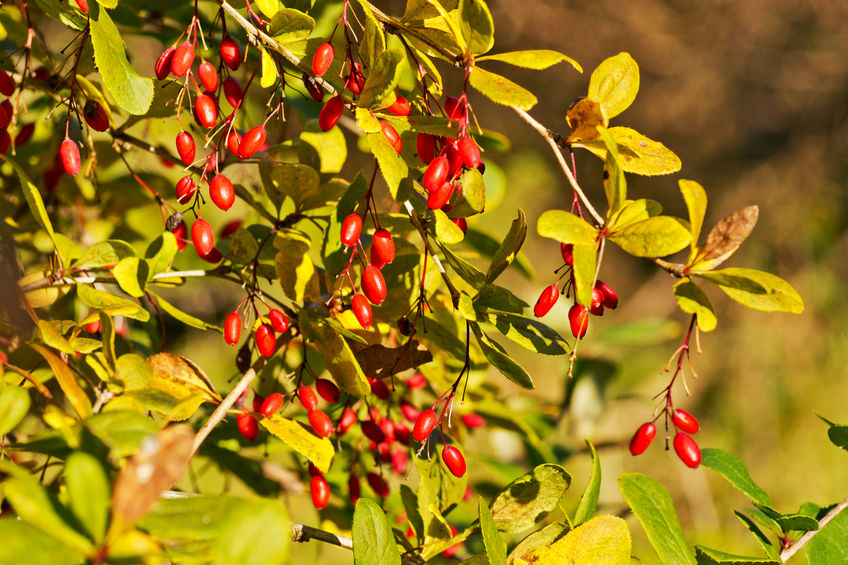Barberry - Berberis vulgaris

Common Names: Barberry, Berberis, Common Barberry, European Barberry, Berberidis Fructus, Berbéris, Berberitze, Berberry, Berbis, Oregon Grape, Piprage, Vinettier, Sauerdorn, Sow Berry, Pipperidge, Espino Cambrón, Lebanon barberry
Latin Name: Berberis vulgaris
Origin: Africa, Asia, Europe, South America, North America
Short Introduction
Many types of barberry are popular ornamental shrubs, prized for their flowers, foliage, and overall appearance. These shrubs are often cultivated in parks, along fences, roadsides, and around buildings.
Detailed Description
A well-known herb appreciated for its disinfectant properties.
Botanical Information
Barberry is a member of a large genus of plants that exhibit diverse characteristics, including dimorphic, elongated shoots. Common Barberry is a deciduous shrub that grows to a height of 1 to 5 meters. Its leaves are simple, 1–10 cm long, white on the underside, and often mixed with spiny leaves that protect the plant.
The yellow to orange flowers grow singly or in clusters of up to 20. The fruit is a small berry, 5–20 mm long, either elongated or round, with a dark red or dark blue color when ripe and a waxy surface.
Origin and Distribution
Barberry grows in temperate and subtropical climates worldwide, except in Australia. There is great species diversity in South America and Asia. Many species are native to Europe, Asia, and some regions of Africa. To this day, the plant grows wild across most of Europe and western Asia.
Usage / Dosage
Yellow dye from barberry was historically extracted from the root, bark, and stem. Most often, barberry is consumed for its high vitamin C content and its sharp, tart flavor.
For centuries, barberry has been used in European cuisine, and it is still a staple in Iranian cuisine, particularly with rice or poultry dishes (known as zereshk or zereshk polo). The dried fruit can be purchased in Persian markets, often sweetened before or during cooking. In Russia, barberry fruit is used to make preserves and jams, while in Poland it is consumed as fresh fruit or cooked. Please note, all parts of the plant—including the berries—contain toxic compounds such as berberine.
The thorns of barberry were used in ancient times to polish gold coins, as they are hard enough to remove corrosion but not to damage the coin’s surface. The berries are a food source for many butterflies and an important staple for small birds, which helps to spread the plant in the wild.
Animal Studies
Smaller studies suggest that barberry supplements taken for 4 weeks may reduce symptoms of acne in adolescents.
Similarly, combining barberry compounds with the antibiotic metronidazole as a cream helped treat bacterial vaginosis.
Other small studies describe a reduction in tooth plaque and gum inflammation after regular brushing with toothpaste or a gel extract of barberry for three weeks.
Some sources indicate that barberry’s compounds have antioxidant, antidiabetic, antibacterial, analgesic, hepatoprotective, and anticancer potential. Further research on barberry extracts may reveal new applications for future therapeutics.
Traditional Folk Medicine
In European folk medicine, herbal blends containing barberry are traditionally used to lower blood sugar in type 2 diabetes over an 8-week period. It is also used to support digestive health, for constipation or diarrhea, as well as for urinary tract infections and kidney issues.
Folk healers also recommend barberry in combination with other herbs for arthritis, fevers, heartburn, and cardiovascular complaints.
Some of the oldest recorded medicinal uses of barberry can be traced back to Assyrian tablets from the reign of Ashurbanipal, indicating its usage in Ayurveda as well. In Ayurvedic medicine, barberry is traditionally recommended for treating eye, ear, and oral infections, supporting weight loss, managing dysentery, hemorrhoids, and for wound healing.
Active Compounds
Dried fruit of Common Barberry is popular in natural folk medicine. Its constituents include triterpenoids, tannins, carotenoids, proteins, anthocyanins, ten phenolic compounds, and isoquinoline alkaloids such as berberine, berbamine, brolicine, columbamine, and oxyacanthine. Barberry contains significant amounts of vitamin C, as well as vitamin K, A, calcium, iron, sodium, dextrose, fructose, tartaric acid, citric acid, pectin, and resins.
Traditional Dosage
Barberry is often combined with other herbs to support healthy digestion. The recommended dose is about 1–2 teaspoons daily, either directly (as a spice) or as a decoction.
